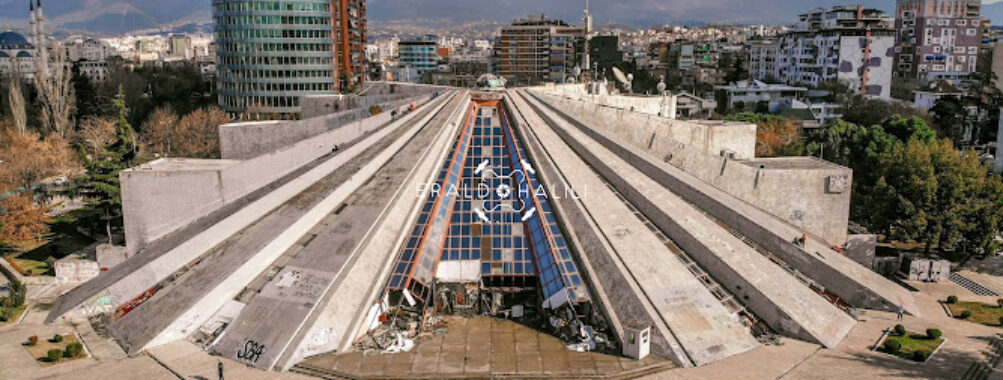
Pyramid of Tirana
“`html
Table of Contents
Description
The Pyramid of Tirana stands as one of Albania’s most curious and thought-provoking landmarks—a structure that has witnessed the country’s turbulent transformation from communism to modern democracy. Originally opened in 1988 as the Enver Hoxha Museum, it was designed by Hoxha’s daughter, Pranvera, and her husband, Klement Kolaneci. Back then, it was meant to glorify the late dictator’s legacy. Today, though, it’s something completely different: a cultural and tech hub buzzing with creativity, youth energy, and a surprising sense of optimism.
If you’ve ever walked past it, you’ll notice how its sloping concrete sides invite people—locals and tourists alike—to climb up and take in the panorama of Tirana’s skyline. I remember the first time I tried it; I wasn’t sure if I’d make it to the top without slipping, but the view was worth every cautious step. The Pyramid is more than an architectural oddity—it’s a symbol of Albania’s resilience and its ability to reinvent itself. Once a monument to control, it’s now a playground for freedom, art, and innovation.
Inside, the building has been completely reimagined. The TUMO Center for Creative Technologies now occupies much of the space, offering digital education to young Albanians. You’ll find bright open areas, art installations, and even co-working spaces where local startups brainstorm over coffee. The contrast between the brutalist exterior and the modern interior is striking—it’s like walking through Albania’s past and future in one go.
Key Features
- Iconic pyramid-shaped architecture that can be freely climbed for panoramic city views.
- Formerly a museum dedicated to Enver Hoxha, now transformed into a tech and cultural center.
- Home to the TUMO Center for Creative Technologies, fostering innovation among youth.
- Open 24/7 for public access, with no entrance fee for climbing the exterior.
- Occasional art exhibitions, concerts, and events held inside and around the structure.
- Close proximity to other major attractions like Blloku and the National Gallery of Arts.
What really makes this place stand out is its accessibility—not in the wheelchair sense, unfortunately, as the structure isn’t particularly accommodating—but in the emotional sense. It’s open to everyone, locals lounging on its slopes, travelers snapping photos, kids skating around, and artists sketching in the shade. It’s a living, breathing space that reflects Tirana’s evolving identity.
Best Time to Visit
If you ask me, the best time to visit the Pyramid of Tirana is in the late afternoon, just before sunset. The golden light hits the concrete at just the right angle, softening its harsh lines and turning it into something almost poetic. That’s also when the locals start gathering—friends chatting, couples taking selfies, kids daring each other to climb higher. It’s the most authentic way to experience the place.
Spring and autumn are ideal seasons weather-wise. The summer heat can make the concrete surfaces scorching, and in winter, it can get slippery and cold. But honestly, even on a cloudy day, the Pyramid has a certain charm. It’s one of those places that feels different every time you visit, depending on the light, the crowd, and your own mood.
How to Get There
Reaching the Pyramid is quite straightforward since it’s located right in the heart of Tirana, along one of the city’s main boulevards. If you’re staying anywhere near the city center, you can easily walk there—it’s maybe a 10- to 15-minute stroll from Skanderbeg Square. Along the way, you’ll pass cafes, small shops, and a few street vendors selling roasted chestnuts or corn, depending on the season.
If walking’s not your thing, taxis and ride-sharing apps are readily available and inexpensive. Buses also run frequently through the area, though I’ve always preferred walking—it’s the best way to soak up the city’s atmosphere. Just keep an eye out for cyclists and scooters darting around; Tirana’s streets can be a bit unpredictable.
Tips for Visiting
Here’s where I’ll let you in on a few personal tips that might make your visit smoother and more memorable:
- Wear good shoes. The pyramid’s slopes can be slippery, especially after rain. Sneakers with decent grip are your best bet.
- Go at sunset. The light, the view, the vibe—it’s unbeatable. Plus, you’ll get some amazing photos.
- Bring water. There’s not much shade at the top, and on a hot day, you’ll want to stay hydrated.
- Respect the space. Even though it’s casual and open, it’s still a place with deep historical significance for many Albanians.
- Check for events. Sometimes there are pop-up exhibitions or performances inside. It’s worth checking local event listings before you go.
- Be mindful of accessibility. The site isn’t fully equipped for wheelchair users, so plan accordingly if mobility is a concern.
One thing I’ve noticed over the years is how the Pyramid seems to bring people together. You’ll see teenagers laughing, tourists marveling, and older locals quietly reflecting. It’s a mix of nostalgia and hope, all wrapped up in one concrete shell. And if you’re lucky, you might stumble upon a street musician playing nearby—those moments give the place a soul that no guidebook can fully capture.
In a way, visiting the Pyramid of Tirana isn’t just about seeing a landmark—it’s about feeling the pulse of a city that’s constantly reinventing itself. It’s about understanding how a nation can turn a monument to its past into a platform for its future. Whether you climb it, photograph it, or simply sit by its base watching life unfold, the experience stays with you. And honestly, that’s what great travel moments are all about.
“`
Location
Places to Stay Near Pyramid of Tirana
Find and Book a Tour
Explore More Travel Guides
No reviews found! Be the first to review!